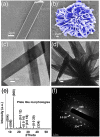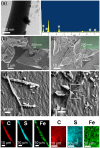Single Crystal Organic Nanoflowers
- PMID: 29229940
- PMCID: PMC5725578
- DOI: 10.1038/s41598-017-17538-0
Single Crystal Organic Nanoflowers
Abstract
Nano-flowers reported so far were mostly constituted of inorganic or hybrid materials. We have synthesized and crystallized a new organic compound, 1, 2-bis(tritylthio)ethane forming an organic nano-flower consisting of single crystalline petals. Crystal structure at nano and micro level indicates that π-π stacking interactions between aromatic systems is the principal factor governing molecular recognition and assembly. Single crystal X-ray Diffraction (S-XRD) supported by Selective Area Electron Diffraction (SAED) experiments indicate the single crystalline nature of the flower-like assembly even at the nanoscale. In order to fabricate the nanoflower as a potential stimulus responsive material; the 'petals' were coated with magnetite nanoparticles, verified by Energy-dispersive X-ray spectroscopic (EDX) analysis. Herein, we have further tested the potential utility of the hybrid material in water remediation as a nano-based adsorbent for removal of heavy metals like chromium.
Conflict of interest statement
A patent has been filed based on this work. Patent No. 201631011471, Dated 31.03.2016.
Figures




References
Publication types
LinkOut - more resources
Full Text Sources
Other Literature Sources
Research Materials
Miscellaneous

